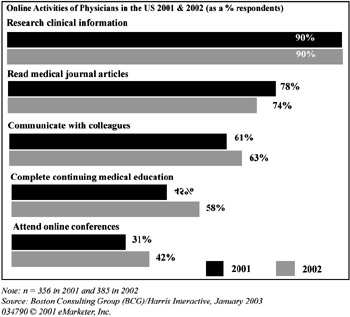Health Information Search Background
|
| < Day Day Up > |
|
The Monday, June 10, 2002, issue of The Wall Street Journal included a special section on e-commerce, in which several articles report the state of adoption of information technology in the health-care industry. As one reporter, Laura Landro (2002), puts it, "The health-care industry finally has little choice: It has to get wired" (p. R6, emphasis in the original). However, most articles in this special section report about utilizing IT for activities such as cataloging patient information, facilitating efficient patient billing (and insurance payments), and effective tracking of disease outbreaks (due to post-September 11 bioterrorism concerns). Yet little is mentioned about how the Internet is utilized for the dissemination of health information, either by sources seeking to "push" the information to patients or by patients seeking to "pull" the information from the Web.
Eysenbach & Köhler (2002) utilized qualitative research techniques to understand how end users locate and appraise health information on the Internet. They found that even though participants stated that they looked at the source of the health information on a website in order to establish credibility, few actually checked to find the source of that information or later recalled from which website they had obtained health information.
Bazzoli (2000) suggests that consumers (patients) and physicians are both using the Web to search for diagnostic and treatment information. Ninety percent (90%) of physicians use the Web to research clinical information, according to a 2002 poll conducted by the Boston Consulting Group and Harris Interactive, while only 74% and 63% read medical journals or consult with colleagues, respectively (The eMarketer Daily, 2002). See Figure 1 for further details.

Figure 1: Online Activities of Physicians in the US
But Ferguson (2002) reported that patients bringing information obtained from the Web to their physician appointments have put a strain on the patient-physician relationship. If a physician refuses to read such information, the patient may become irritated. Also, the information might be unrelated to the patient's condition or reveal lack of knowledge on the part of the physician. Further, The Pew Internet and American Life Project (Fox & Rainie, 2000) conducted a study of the frequency of web access by end users to seek health information, which revealed that 52 million American adults have used the Web to get health or medical information, 48% of these health seekers say such advice has improved the way they take care of themselves, and 91 % of health seekers have looked for material related to a physical illness. [In general, online shopping comes naturally to young consumers (Forrester Research, 2000), and online shoppers are generally younger and more highly educated than conventional consumers (OECD, 1998; Kotkin, 1998).]
However, no studies have specifically examined the relationships between patients' motivations for using the Web and the outcomes of their search endeavors. This chapter develops a model of end user search for information via the Web, helping to explain end user behavior when using the Internet to locate information.
|
| < Day Day Up > |
|
EAN: 2147483647
Pages: 191